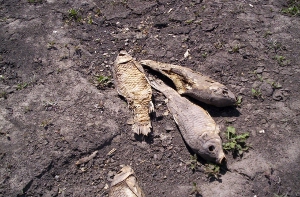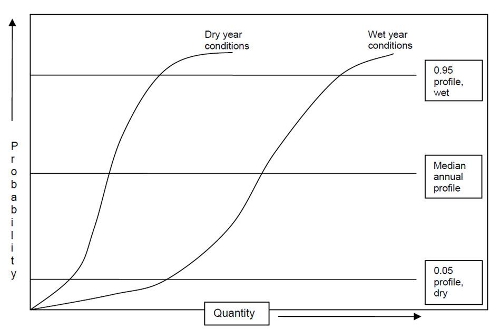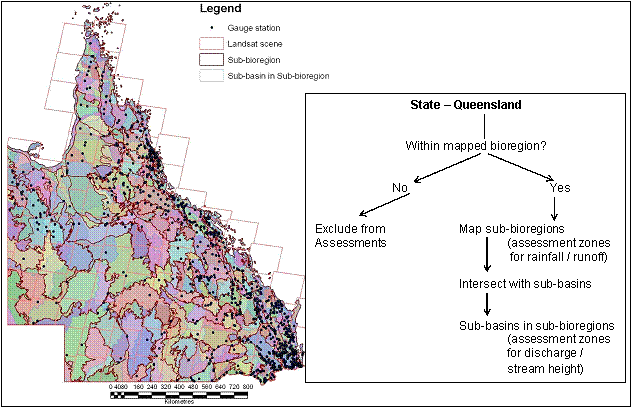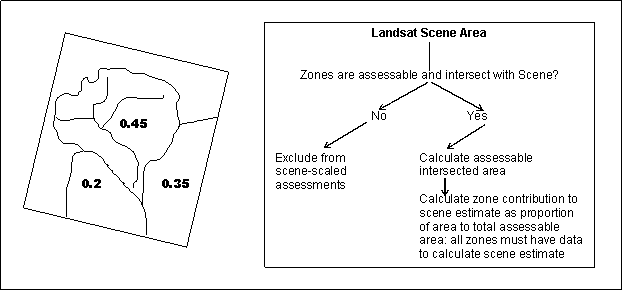|
|
Hydro-climate Tool Frequently Asked QuestionsThe information contained in this section is about the wetland hydro-climate tool developed as part of the Queensland Wetlands Program wetland mapping. If you cannot find the answers you are looking for in the Frequently Asked Questions here, in the methodology Hydrological Characterisation for Wetlands and Wetland Imagery or the users guide, please use the feedback button below to contact us.
Quick facts
Hydro-climate FAQsWhat is the purpose of the wetland hydro-climatic tool?This tool models hydro-climatic conditions of wetlands across the State of Queensland to:
The tool defines the temporal scope of hydro-climatic conditions and facilitates time series evaluation of seasonal state and annual trend. The tool conveys this information by using maps, imagery, bar charts, data extraction, benchmark references and reference curves that are scaled by probability of exceedence. Metadata is provided to facilitate the quality control of data use and interpretation. The tool is provided by the Queensland Wetlands Program to support the assessment, evaluation and management of Queensland wetlands for government, scientific institution, natural resource management, education and general public applications. The tool uses simple evidence-based methods to characterise hydro-climatic conditions and is not intended to support prescriptive or specific diagnostic applications. Is this tool relevant for statutory water resource planning?No. For applications and enquiries relating to water resource planning in Queensland refer to the information on water resource planning. However, the tool is relevant to the monitoring and assessment of Queensland's wetland conditions. It provides an important perspective on the eco-hydrology of these environments and can help explain aquatic ecosystem processes and functions. What is hydrological attribution?In the context of this tool hydrological attribution is the role of the tool to attribute rainfall, run-off, discharge and stream (i.e. stage) height characteristics through date and time. The period of record extends from 1889 to 2006 for rainfall, from 1890 to 2006 for run-off, and from 1900 to 2006 (generally 2005) for discharge and stream height data. Direct attribution occurs when a date for a record exists in the database and can be compared with reference historical data. This record is comprehensive for rainfall and run-off data but discontinuous for stream data. If alternate stream data observations exist for times not attributed in the database, the alternate data may be calibrated to archived reference data to infer characteristics (attributes) for the data assessed. Why does wetland mapping require hydrological and climatological attribution?The provision of hydro-climate information is an additional attribute for the wetland mapping, classification and inventory products recommended by peer review (refer to FAQs about the wetland mapping and classification product). The information provides historical context explaining the representativeness of hydro-climatic conditions expected for the landscape and aquatic systems classified through Landsat imagery for specific dates which were used in the wetland mapping. The hydro-climate data and reference information:
This attribution facilitates the evaluation of wetland conditions for wetland monitoring and assessment. For example, off-stream swamp wetlands may have inflows sourced mainly from rainfall and run-off whilst stream dependent lake features may be more closely linked to stream discharge and height. The provision of these data may profile wetland filling characteristics which must be understood to facilitate wetland management. Because streamflow information is not comprehensive, rainfall and run-off data provide essential context for all scene and wetland assessments. What is eco-hydrology?Eco-hydrology or landscape limnology is a scientific approach to the combined evaluation of ecological, biological and aquatic processes, functions and patterns at a range of scales with an emphasis on spatio-temporal connectivity and context for patterns and processes[8][11]. Applications in eco-hydrology require appropriate tools and context to maximise the power and meaning of interpretations for concepts that span landscape and aquatic disciplines. This method uses a hierarchical, multi-temporal, stochastic approach within ecologically defined assessment regions to maximise the number of potential eco-hydrological connections for different wetland types and environmental contexts. How is the information produced?The rainfall, run-off, discharge and stream height items characterised by these tools are produced using the methods published in Hydrological Characterisation for Wetlands and Wetland Imagery: A method to attribute and evaluate hydro-climatic conditions for the Queensland wetland mapping, version 1.1. (DERM 2010). The key principles for data development are:
In particular the method recognises that within zone variability may be large and influenced by heterogeneous hydro-climatic conditions. The method provides 3 hydro-climate reference regimes to characterise wet (upper 95% of conditions), median and dry (lower 5% of conditions) annual states, and provides realistic 90% confidence intervals (using binomial theory[2]) around the median regime (daily to monthly data only) (Figures 1 and 2). Reference statistics along with measures of variability including a ratio of annual to long-term variability (which can be tested using the F-test statistic) are provided to characterise the variability of time series data and the representativeness of zonal statistics[12][4][3][5][10][12][13]. Database programming enables the selection and charting of data series, selection of metadata and selection and charting of reference probability of exceedence curves. Downloads of selected data relate zonal quantities to probabilities of exceedence in each hydrological regime. This enables the characterisation of wet, normal and dry conditions by month (and therefore season) or further data analysis to evaluate potential trends in hydro-climatic conditions.
Figure 1: Profile annual dry, median and wet rainfall, run-off, discharge and stream height data to provide the information to characterise within-year and inter-annual variability through ordered probabilities or exceedence for each temporal scale assessed.
Figure 2: Idealised example for the interpretation of variability and representativeness of quantities ordered by probability of exceedence for each hydro-climatic regime and reference time scale. Curves with a larger range of quantities represent conditions of greater inter-annual variability whilst the degree of within-year variability is indicated by the separation between the reference series.
Figure 3: The state of Queensland (north-east Australia), defined by assessment zones and overlain by 87 Landsat scene footprints. The derivation of assessment zones is illustrated on the right. What is an assessment zone and eco-region?The assessment zones are physiographic regions with similar climatic or hydrological conditions and physical geographic context. These zones are defined by eco-regions (sub-bioregions) and sub-basins. There are 120 sub-bioregion assessment zones (average area of 14,120 km2) with similar vegetation, landform pattern, elevation, geology and rainfall, for application of rainfall and run-off data, and 253 sub-basins within sub-bioregion assessment zones created through intersection of sub-bioregions with sub-basins (average area of 4580 km2) (Figure 3) for application of stream gauge data. An eco-region is defined here by similarity between ecological and hydro-climate characteristics and includes the sub-bioregional areas and sub-basin areas within them. Assessment of data within eco-regions increases homogeneity in data values and therefore consistency between hydrological and ecological processes[11]. Why is detailed multi-temporal information useful?It is impossible to determine (route) flow storage and transfer processes for most wetlands because the detailed information to do this does not exist. Moreover, the influence of soil interflow and groundwater on wetland storage is largely unknown, and many arid river systems and wetlands transfer large quantities of water from catchments located very large distances away, and it may take more than 3 months for a flood pulse to pass. Seasonal hydro-climatic conditions, durations and timing of events can vary dramatically across the 1.9 million km2 of Queensland that span latitudes 9.5 to 29.15 degrees south. In some coastal catchments hourly to daily hydrographs are ideal to describe the effects of storms, whilst in the tropical north-west weekly hydrographs may be sufficient. Far south western Queensland desert rivers and catchments are mainly dry but local flows may be produced by local storms or deep depression systems to the north, resulting in a wide range of flood durations. Detailed multi-temporal information provides the best opportunity to characterise the influence of different sources of water for their different processes of accumulation and transfer. Profiling all hydro-climate data by the same reference scales enables the filling of each wetland with recorded inundation to be characterised by an ensemble of water sources over different time durations, such as rainfall and run-off over a week but discharge over a month. This maximises the potential strength of assessments for different wetland types and environmental conditions. Longer temporal sampling also provides stationarity where more heterogeneous hydrological processes exist, such as punctuated flows versus extended flood peaks in the desert rivers. This scaling effect may improve the precision of models that characterise wetland filling. How do the tools represent variability in hydro-climatic conditions?Variability is an intrinsic characteristic of the time series data. Figure 1 shows how variability occurs within years and between years and how each regime level samples ordered statistics. Figure 2 shows how the regime statistics are ordered by the calculated probability of exceedence (probability of equalling or exceeding an occurrence) across all years to reveal an ideal range in quantities between years. Any year of conditions would be expected to have dry to wet periods assessable at an appropriate time scale against the reference curves, thereby representing ideal within-year variability. Extracted zonal data for a particular date and time period includes the probability of exceedence for each data value for each reference curve. The derived probabilities are representative of annual exceedence conditions in the assessment zone so event probabilities represent annualised recurrences for a reference time scale (e.g. 1 in 10, 20 or 100 year events)[12]. Data that are extracted using the download tool are allocated probabilities of exceedence by each reference regime. The allocation of probabilities to the data within and across years may be used to characterise the seasonality of wet conditions. Evaluation of the timing and magnitude of wet cycles between years may indicate variation in seasonal conditions. Confidence interval values in the extracted data indicate values around the median that are expected to share membership with normal conditions, given normal (random) variation in a normal year of observations. Reference curves that show larger ranges in quantities within regimes characterise larger interannual variability whilst larger ranges in quantities between regimes characterise larger within-year variability (Figure 2), usually at the dry end of the spectrum (large probabilities). If the median's confidence intervals lie close to the wet and dry regimes (e.g. for stream heights measuring flows in groundwater dependent ecosystems), then many variations are statistically insignificant. The charts display this information for interpretation. In addition, the downloadable data and metadata provide reference and benchmark information for comparison. The annual metadata includes the coefficient of variation and the ratio of annual to long-term variance of logs for values through a year. These items describe the relative dispersion of values within a year, and the deviation of a year's variability to the long-term measure which can be tested using the F-test statistic. An explanation for the test is provided in the Hydrological Characterisation for Wetlands and Wetland Imagery: Users guide to attribute and evaluate hydro-climatic conditions (DERM 2010) using the WetlandInfo tools for hydrological characterisation for wetlands and wetland imagery (version 1.1.). How do the tools identify the representativeness of conditions?Representativeness is an intrinsic characteristic of zonal values when compared to the reference population of zonal values. However, because the maximums and minimums are not profiled, some observations must fall outside of the assessable range and be assigned a probability of 0 (which indicates the conditions are very unlikely to occur over the whole zone for the regime and time scale assessed) or not assessable (NaN) if the value is smaller than the assessable range. Most observations will share membership with one or more of the reference regimes. When the values fall mainly within a regime, and mostly occur with a probability of 0.5 for a regime, then those values, say for a season, are representative of that regime's conditions (e.g. wet period conditions) (Figure 2). Representativeness will vary with the influence of events and how they are distributed across a zone. High rainfall mountainous areas may consistently represent rainfall in the wet regime while lowland areas may be characterised more by dry regimes. Representativeness is also influenced by the variability of hydro-climate processes. For example in the lower Diamantina basin, the ratio of variances at a daily scale may show that 'normal conditions' at a daily time scale are uncommon (occur 19% of the time) because contrasting years with drought or flood dominate the record. For these data and time scales representative conditions are really either the wet or dry times. When the data are scaled to a monthly time scale, 92% of annual conditions are identified as 'normal' and these data are well represented for the period of record assessments through the reference series. Is the information biased by modelling methods?No, not so far as the modelling does not use potentially biased parametric methods, such as parametric period of record modelling in areas of variable hydro-climatic conditions. Instead the method takes an evidence-based approach to represent the zonal statistics to the same degree of variation as the data presents. In addition the annualised approach reduces bias to persistent conditions, which is characteristic of parametric period of record methods[12]. However the output is only as good as the representativeness of the zonal statistics, and representativeness in reality varies in space and time. In particular the combination of non-similar hydrographic properties can cause significant within year variation. This method accommodates this variation by normalising each gauge station's data to its long-term mean before collation of zonal statistics. The resulting zonal statistic is a mean of normalised values, which at a daily time step is centred around 1.0. The normalised index values are later scaled up by the estimate of zonal long-term daily discharge (or height) data. This means that:
Rainfall and run-off statistics are driven by rainfall modelling through a 0.05 degree grid. The interpolation method used[6][7][9] imparts some bias where meteorological data is sparse and in mountainous or rain-shadow areas. Sub-bioregion zones help reduce some of this bias, but some undesirable effects will persist. If these anomalies or discontinuities are an issue, users should seek to relate time series or reference series values to 'exact' values to calibrate zonal statistics to local observations. This will increase accuracy although precision will still be as variable as the underlying factors (e.g. variability in gauge station contribution) and will not account for climate change or changes occurring largely outside of the period of time sampled by the zonal statistics. How do I identify years which had unusual hydro-climatic conditions?First, look at the charts for the selected data type, date, and time period using annual totals. Unusual years should show a marked deviation from the long-term mean. Reassess the same data at a weekly or monthly time scale over many years and membership with wet or dry regimes should be apparent. Extract the data at a monthly scale and identify membership of quantities with each regime. It is likely that normal seasonal conditions will not be recorded. If membership with the median is of interest, compare the values with the median's confidence intervals. Alternatively, extract a long period of record and evaluate the F-test statistics as per the user guide (section 3.3). Years with unusual within-year variability relative to the long-term variability will be identified (you will need to use your own spreadsheet or statistical software to facilitate this). Chart the time series data for that year and longer periods of records at different time scales to identify the characteristics that make that year of conditions appear unusual. Is the information comprehensive?The time series of rainfall and run-off data is comprehensive over the period of record. In some far northern and eastern coastal areas the population of run-off grid cells is a little less than the rainfall data (e.g. areas with offshore islands). Stream gauge data is distributed unevenly across the state with station operation often being for limited durations or episodic. This is a reason why zonal statistics are required to spread information across large areas when sparse or unreliable information exists. Each gauge station's contribution was quality controlled before collation, but whole years are required to produce annualised statistics. Therefore many zones do not have discharge or stream height information at all or not for a significant number of years. At least 4 years of data are required to estimate reference curves, but at least 15 or 20 years of records are recommended to provide information that is representative of most annual and seasonal conditions. Where missing zonal information is an issue, users should attempt to characterise conditions on the basis of rainfall or run-off alone. If contemporary streamflow information is available, this could be calibrated to the archived data to provide a link to reference curves and assessment of probabilities of exceedence, assuming no major changes in hydrologic processes has occurred in the interval of time between the years used to derive reference data and the contemporary observations. Where can I find current data and period of record information?Current or archived rainfall data or maps may be accessed on the following web pages:
Run-off data or products are available at: Discharge and height information is available at:
Users should note that newly installed or other gauge stations may be listed on other websites, and that Bureau of Meteorology stations include stations not monitored by the Queensland Department of Environment, Science and Innovation. How do I access imagery?The imagery used in wetland mapping is shown in the Landsat scenes tool. The tool shows the scene frame identification. Scenes selected from the tool provide a link to 'Satellite Images'. These may be viewed as required for comparison with hydro-climate statistics. Other Landsat imagery may be acquired relative to the scene identification for Landsat 5 and 7, or relative to town names or gauge station coordinates as shown on a number of the maps. Landsat imagery may be obtained from the Geoscience Australia Earth Observation Catalogue System (ACRES) or the United States Geological Survey. Free multi-day enhanced broadscale MODIS imagery can be accessed through CSIRO. This imagery is useful identifying broadscale floods or other broadscale landscape changes. How can I interpret conditions across a scene when some assessment information is missing?This situation is common at a scene scale for stream gauge data because the aggregation of zone information to a scene scale is not dynamic but depends on the coincidence of all assessable zones with assessable data records (Figure 4). Quite often the only assessable period is during the 1980s, or if short-period data records are included. In these circumstances users should select a surrogate indicator (rainfall or run-off), compile scene-wide quantities for that data, date etc., then select a zone of interest for comparison. Profile zonal data for that date to compare its representativeness to the scene quantities. Proceed to assess the probabilities of exceedence for those conditions in that zone (probabilities can only be calculated for specific zones) to characterise within-zone conditions. Note that this approach will not account for flow accumulation upstream so conditions should also be characterised in relevant adjacent areas.
Figure 4. Relationship between assessment zones (shown on left), assessable records and calculation of scene-wide estimates (shown on right) through zone area weights (shown in bold on left). What are some key applications I can achieve with this information?The information is provided to characterise conditions only and no modelling support will be provided. Users should read the methodology and user guide before embarking on any modelling activities. Zonal boundary mapping will not be released and it is the responsibility of the user to ensure assessments are performed in the correct area. Examples for application include:
What are the key limitations for the use of the data and tools?
Will the information be updated?Updates will occur periodically as resources allow and as required due to updates to zone boundaries. Where can I find additional information about the method and applications?The Hydrological Characterisation for Wetlands and Wetland Imagery – A method to attribute and evaluate hydro-climatic conditions for the Queensland wetland mapping is downloadable. Further research can be conducted using the references provided and the resources available on the internet. For example, flood observatory information may be accessed at Sentinel Asia International programs for data collation and inventory may be accessed at Global Run-off Data Centre (GRDC). Can I request data?Yes, DVD copies of zonal data may be requested for specific circumstances, including collaborative research and development with the Department of Environment, Science and Innovation for wetland assessment and management. Other circumstances may include educational applications, such for demonstrating scientific applications in schools or universities. Users should note that significant programming underlies the use of the data and that the data supplied will be in its basic zonal, metadata and reference series format. It is the responsibility of the user to compile comparable information to what is accessed through the internet. At this stage users are recommended to use the web interface for limited data extraction and more significantly for general exploration to characterise zonal hydro-climatic conditions. No zone GIS files will be generally released for data security reasons. Information about source data (rainfall, run-off, streamflow and height) can be obtained from Queensland Government sources such as the Long Paddock website, the SILO climate database and water monitoring page. General steps required to order zonal data from the Queensland Wetlands Program. 1. Read the disclaimers and copyright information. 2. Read and acknowledge the purpose for data use by the Queensland Wetlands Program. 3. Read the methodology document and acknowledge the implicit limitations in the data. 4. Identify the assessment zones of interest via zone labelling in the tools. Only zonal statistics will be released for use. 5. Write a summary explaining your requirements and purpose for data application. 6. Send your request with your personal/institutional contact details via email to data.coordinator♲science.dsitia.qld.gov.au. 7. For requests linked to research projects agreements for collaboration may be required. This may include requirements for information sharing and publication. 8. Publications using the data must cite the source of data. 9. The Department of Environment, Science and Innovation reserves the right to review articles that use data from the WetlandInfo database prior to their publication. 10. The sharing of scripts used by WetlandInfoinfrastructure will not be permitted. Users requesting data may be instructed to use some specific algorithms to scale daily data. Licence conditions1. Accept the disclaimers and conditions. The department reserves the right not to be responsible for the correctness, completeness or quality of the data and the effects of this on derived products. While every effort is made to ensure the data is correct and without error, some errors unknown to the department may persist. The department will not be held responsible for the consequences of the use of this departmental data. 2. Negotiate applications, publications and orders through opendata♲des.qld.gov.au. Commercial and non-commercial data uses will be negotiated differently as required by departmental guidelines and requirements. References
Last updated: 22 March 2013 This page should be cited as: Department of Environment, Science and Innovation, Queensland (2013) Hydro-climate Tool Frequently Asked Questions, WetlandInfo website, accessed 18 March 2024. Available at: https://wetlandinfo.des.qld.gov.au/wetlands/resources/tools/hydro-climate/faq/ |

 — Department of Environment, Science and Innovation
— Department of Environment, Science and Innovation






